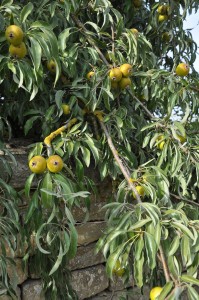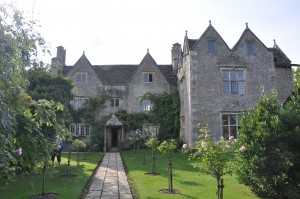Nüvi: “In 0.6 miles turn right on road.”
Nüvi: “In 1.3 miles turn left on road.”
Left to our own devices, we would never have headed down an unnamed macadam track even if we thought that Kelmscott Manor was somewhere in that general direction. Left to a GPS device, we did not hesitate.
And in a few minutes we arrived in the hamlet of Kelmscott, once the rural refuge of William Morris, poet, socialist, visionary and pater familias of the English Arts and Crafts movement. Cuckold as well. Kelmscott was originally a shared lease with Dante Gabriel Rossetti, founding member of the PreRaphaelites and lover of Morris’ wife Jane. Today the village remains a monument to Morris and his work. First Jane, and then their daughters May and Jenny commissioned buildings that were both testament to the ideals Morris held dear and the affectionate memory of an extraordinary artist and generous spirit.
What I wonder, however, is what the heck Morris saw in Jane?
Sure she was quite the “stunner,” this child of an Oxford stableman, a girl of long neck, pouting lips and masses of dark waving hair. One understands that she seemed the embodiment of beauty to a pack of randy young artists looking forward by looking back to the art of the early Renaissance. Rossetti saw her first and she modeled for him and then for Morris, but Morris married her. They lived in London and Morris built his business producing decorative arts, tapestries, wallpapers, tiles, stained-glass windows and the like. Meanwhile Jane and Rossetti became more intimate than society could allow for a married woman and recent widower.
Jane lounged on settees and chairs, working on embroideries and tiles for her husband and claiming malaise. Did she have thoughts? Did she offer conversation? Morris spent considerable time traveling to Iceland in scholarly exploration of ancient cultures and attending to business in London. Rossetti painted, wrote poetry, sulked, threw fits, indulged in drugs and eventually abandoned this utopian experiment.
Go figure.
It was the perfect end to our own idyllic day. We went from place to place, first to the utterly enchanting village of Great Tews with its rows of thatched cottages and then to Chipping Norton where we found wrapping paper for the gifts for the bride and groom and the groom’s sister. In a tiny jewelry shop—a place whose floor space was far less than most store’s display space—and my Dear One added another charm to my necklace. This one is a top hat, something both terribly “My Fair Lady” English and evocative of the elegance of this wedding we will attend.
I am enjoying these excursions to places where people’s lives shaped their art. Yesterday we bused into Oxford town—note to self: use Pear Tree Park and Ride and not Thornhill—and prepared for Kelmscott with a visit to the exhibition at the Ashmolean, “The PreRaphaelites and Italy.” We ate lunch at the Eagle and Crown, known to the “Inklings” as the “Bird and Baby.” Imagine going for a pint and having C.S. Lewis, J.R.R. Tolkien and other literary luminaries vociferating at the adjacent table.
We replenished our sugar supply at the Fudge Kitchen on Broad then strolled from the Sheldonian past Radcliffe Camera and the church of St. Mary the Virgin to the iron gates that kept us away from the Hawksmoor towers built for All Souls.
By that time we were beat. It was home to New Cottage, a little supper and a little more red wine and to bed.
Days of wine and romance.


